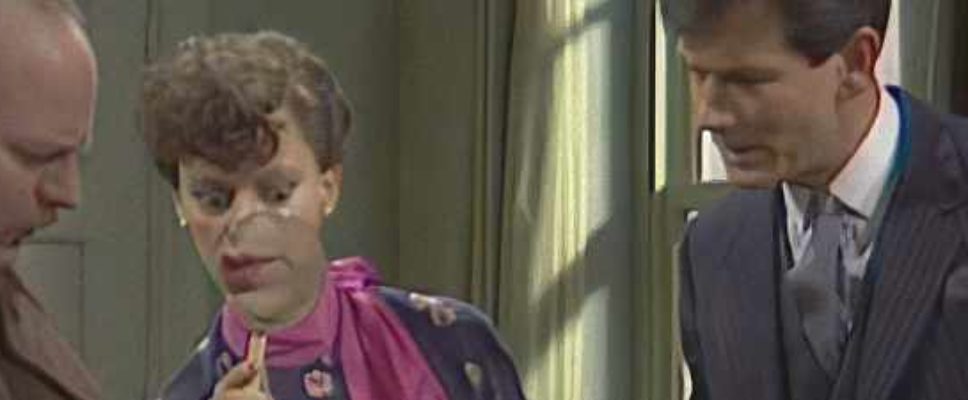Teresa Reviews “The Crackler” (1983)
Teresa reviews “The Crackler” (1983) the last “Partners in Crime” episode, and thought it was a wonderful capstone to the series.
 Fidelity to text: 4 counterfeiters. The plot’s expanded but everything you see was hinted at in the text.
Fidelity to text: 4 counterfeiters. The plot’s expanded but everything you see was hinted at in the text.



Read more of Teresa’s Agatha Christie movie reviews at Peschel Press.
Also, follow Teresa’s discussion of these movies on her podcast.
The final episode of Partners In Crime used (depending on how you’re counting) the 8th or 10th story in the sequence. Since the short story collection had an overall story arc with an actual conclusion, I was hoping that some of that ending would make its way into the final episode. No, it didn’t.
In the book, after many adventures in the detective business, culminating with one last kidnapping as part of an international espionage case, Tuppence retires from the field. She’s going to have a baby.
The TV series just ends.

In The Crackler, she parodied Edgar Wallace (1875-1932). He was a hugely popular, immensely prolific author of his day. He wrote mysteries, thrillers, suspense, action-adventure, a bit of science fiction, and whatever else brought in money to feed his gambling habit. He wrote a variety of forms: nearly 200 novels, a thousand short stories, plays, and screenplays. Over 160 movies were based on his stories. The one everyone remembers today is King Kong. He was able to write so fast because he dictated onto wax cylinders and teams of secretaries typed the manuscripts. One and done was his motto.
Another famous novel he wrote was The Green Archer (1923). A mysterious green-clad archer is involved, ala Robin Hood. It was filmed in 1925 and again in 1940. The second movie serial led directly to DC’s Green Arrow. No Green Archer appears in this episode but you should know this trivia anyway.
The Crackler takes full advantage of Wallace’s breakneck writing style and loosey-goosey plotting. The action never stops. It also showcases Inspector Marriott and how Scotland Yard’s troubles with the aristocracy impeded policework. He can’t send constables to infiltrate the Python nightclub and secret gambling den. They’d be spotted instantly. He also can’t raid the joint because the patrons are too high up the food chain. They’d rain down turmoil upon Scotland Yard because, after all, the higher the noble, the more the law doesn’t apply. They’re special, don’t you know.
Unless the case can be proved, beyond all shadow of a doubt, to a jury of his peers in the House of Lords. Then and only then can Scotland Yard get their man.
Thus, Inspector Marriott once again needs Tommy and Tuppence, just like he did in Finessing the King.


They’re Marguerite Laidlaw (she’s French so she’s automatically untrustworthy), her husband, Major Laidlaw, and Marguerite’s father, Monsieur Heroulade.


The Python Club is everything you’d hope for. There’s a dance band, cocktails flow like water, the patrons wear drop-dead gorgeous clothes, and the gambling den behind threatening tuxedo-clad gorilla doorman is ever so slightly seedy without being tacky or low class. The gambling is very high-stakes, the sort that Edgar Wallace adored losing money at. There’s a charming bartender too.


It seems Marguerite lured Hank into some kind of scavenger hunt in Whitechapel, where she found stacks of crispy, crackling pound notes. Off they go and Tommy discovers he’d been had.


Madame Fahmy (Marguerite Marie Alibert, 1890-1971) eventually, after a very checkered career including an affair with the Prince of Wales, married an Egyptian aristocrat, Ali Kamel Fahmy Bey. They had a contentious relationship and in 1923, she shot him multiple times in their suite at the Savoy hotel. Agatha would have known the story. Madame Fahmy got off in an English court. The Egyptian court — where she sued to get access to her dead husband’s money — was less forgiving.
As for the soldier and the princess and the chalk? That’s the Hans Christian Anderson story, ‘The Tinderbox’. After many adventures, the soldier gets a magic tinderbox. He kidnaps the sleeping princess to admire her but an astute lady-in-waiting marks the doorstep with chalk. Sadly for her, the kidnapper marked all the other doorsteps with chalk so the princess’s location isn’t discovered.
Tommy runs into the same problem, but in true Edgar Wallace style, he pulls a solution out of his pocket. Alleys have alley cats and he likes being prepared so he carried with him a vial of tincture of valerian. Valerian is a potent drug for cats, right up there with catnip, although not as commonly available. When Tommy marks the doorstep with chalk, he also pours out the valerian.
It doesn’t matter that the kidnapping counterfeiter marked all the other doorsteps in the alley with chalk crosses. Only this doorstep has a herd of dizzy, stoned cats meowing and rolling around and generally behaving like barflies at the end of the evening.
The constables rush in to save Tommy, as does Tuppence and Albert.
Albert! He had his adventures too! He got to follow Major Laidlaw and M. Heroulade through the English countryside on his motorcycle and get threatened by the chauffer and then tell a very different version of his adventures to Tuppence.
The Crackler was a nice ending to the series. Partners in Crime could be uneven, but there’s always something to like about each episode. It could be Tuppence’s stupendous wardrobe, their unshakable thirst for cocktails, their chemistry, or even a genuine mystery.

